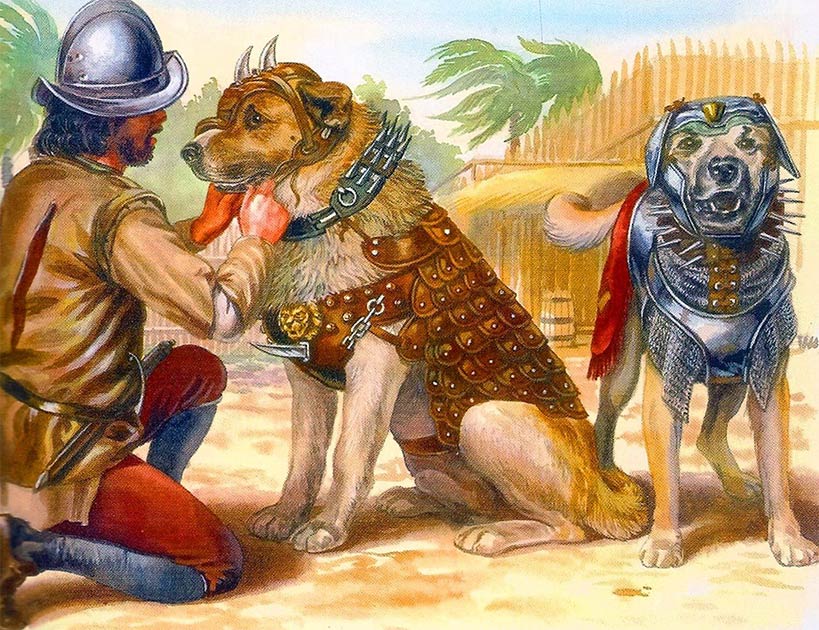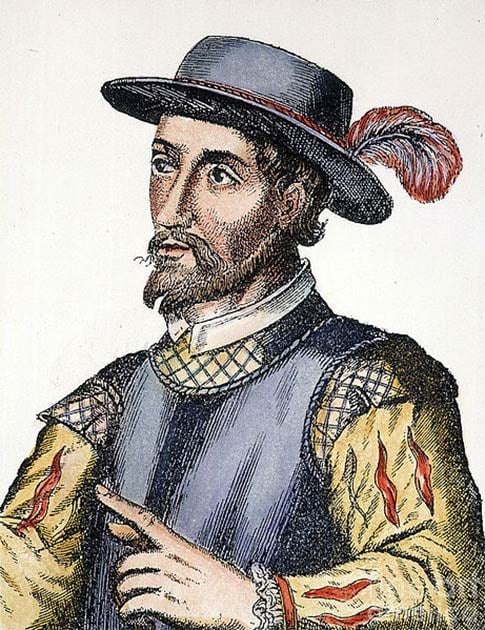
Becerrillo: The Terrifying War Dog of the Spanish Conquistadors
Dogs have been used as powerful weapons of war for at least the last 3,000 years. The ancient Egyptians, Greeks, Persians, Sarmatians, Assyrians, Britons and Romans are all known to have used dogs in combat, or for scouts, sentries, trackers, or executioners. But the Spanish conquistadors employed war dogs on a scale that had rarely been seen before, and with devastating effect, and Becerrillo was their most prized weapon of war.
Origins of War Dogs
Often dubbed man’s best friend, dogs have been partnered with humans and used in warfare since their domestication more than 50,000 years ago. Not just for attacking, work hounds were used for protecting livestock or property, or for simple companionship.

The earliest written account of war dogs comes from a classical source regarding Alyattes, King of Lydia. The war dogs are said to have attacked and killed invaders in a battle against the Cimmerians around 600 BC.
In antiquity, troops from Anatolia used war dogs in conjunction with cavalry. Riders were said to release their hounds on the enemy to disrupt and soften lines, and then the mounted warriors would charge, to devastating effect.
Xerxes I of Persia invaded Greece in 480 BC and brought large packs of Indian hounds.
War dogs are said to have been present at the Battle of Marathon, dating to 490 BC, between the Greeks and Persian Empire.
Centuries later the Roman army used various breeds of work and war dog, but it is recorded the heavy and capable Canis Molossus or Molossian was specially bred just for combat.
The Celtic warriors challenged Caesar’s landing in Britain in 55 BC with their intimidating English Mastiffs. Mastiffs are cited as one of the oldest recorded breeds, since Caesar described them in his accounts.
Dogs in the New World
Christopher Columbus was the first to use dogs as weapons in the New World. He released them upon the indigenous people of Hispaniola in 1493 and to disperse groups that came to stop his landing in Jamaica in 1494. But it was the Battle of Vega Real in 1495 that awoke Columbus to the potential that dogs had as weapons against the inhabitants of this new land.
On March 27, 1495, Columbus and his brother Bartholomew marched inland on Hispaniola with 200 men, 20 horsemen, and 20 Spanish Mastiff dogs to do battle with the Arawak natives , who were opposing Spanish rule. The forces were led by Spanish conquistador Alonso de Ojeda, who had learned the art of using war dogs in battles against the Moors of Granada . In The Pawprints of History: Dogs in the Course of Human Events , author Stanley Coren describes the scene:
“He gathered the dogs on the far right flank and waited until the battle had reached a high level of fury. He then released all twenty mastiffs, shouting “Tómalos!” (meaning “take them”). The angry dogs swept down on the native fighters in a raging phalanx, hurling themselves at the Indians’ naked bodies. They grabbed their opponents by their bellies and throats. As the stunned Indians fell to the ground, the dogs disemboweled them and ripped them to pieces. Spinning from one bloody victim to another, the dogs tore through the native ranks.”
With each subsequent voyage to the Americas, hundreds and then thousands more dogs were brought over. The most popular breed was the mastiff, which could weigh up to 250 pounds and crush bones with its massive jaws. Their sheer size and fierce look instilled terror among the native population. Famous conquistadors, like Balboa, Velasquez, Cortes, De Soto, Toledo, Coronado and Pizarro, all used dogs as instruments of subjugation, execution and as a form of psychological warfare. But it was Juan Ponce de León , a top military official in the colonial government of Hispaniola, who unleashed the fiercest warrior of them all – Becerrillo.
Becerrillo: The ‘Bull’ That Was Trained To Kill
Becerrillo, a name meaning ‘Little Bull,’ was a brown-eyed, red pelted mastiff owned by Spanish explorer Juan Ponce de León but often entrusted to the care of conquistadors Captain Diego Guilarte de Salazar and Sancho de Aragón.
Becerrillo’s origins are uncertain, but it is believed he was born in the Americas in the kennels of Ponce de León. The earliest records of him date to 1511, but by then he was already described as sporting battle scars.
Ponce de León was the conqueror of Puerto Rico . After landing there in 1508, he filled his pockets with gold before convincing Christopher Columbus’s son, Diego, to declare him governor of the island. He then set out with men and dogs to subdue the native population and become rich. 
17th century Spanish engraving (colored) of Juan Ponce de León ( Public domain )
He trained his prized possession Becerrillo to become a powerful weapon. The dog was taught to distinguish between the Spanish and the natives, to search out and cut down runaway captives, and to kill in battle.
The 16th-century Spanish historian and chronicler, Bartolomé de las Casas, reported that Becerrillo “attacked his enemies with frenzied rage and defended his friends with great courage…,” adding that the indigenous people were “more afraid of ten Spanish soldiers with Becerrillo than a hundred by themselves.”
Becerrillo was so skilled at tracking down, killing and terrorizing the natives, that he was worth 50 soldiers to Ponce in his campaign to subdue the Taíno people of Puerto Rico.
In 1512, Ponce de León’s luck would change. Diego Columbus became envious of the riches that Ponce de León was acquiring in Puerto Rico. Diego convinced the king to name him governor instead, officially usurping Ponce. Not ready to let go of his pursuit of wealth, Ponce secured a grant to conquer an island named Bimini, that rumor had it was full of gold and treasures. He set sail in 1512, leaving Becerrillo under the care of Guilarte de Salazar and Sancho de Aragón .
Salazar was quick to utilize Becerrillo in battle. One night, Becerrillo alerted the conquistadors of a surprise attack being launched by the natives. Salazar launched into action with the dog by his side, and in just 30 minutes, Becerrillo had savaged and killed 33 of the natives, leaving behind a battleground of bodies.
Becerrillo Shows Mercy
While Becerrillo had been trained to kill, one historical account, related in Coren’s Pawprints of History , tells a tale of mercy. The conquistadors were camped outside the settlement of Caparra in Puerto Rico waiting for the arrival of the Spanish governor. Looking for something to amuse themselves, Salazar gave a folded piece of paper to an old woman, telling her to deliver it to the governor. As the woman began on her way, Salazar released Becerrillo commanding him to kill her. As the dog raced towards her, the woman dropped to her knees and was reported to have called out “Please, my Lord Dog. I am on my way to take this letter to Christians. I beg you, my Lord Dog, please do not hurt me.”
Becerrillo sniffed the woman and then, disobeying his master’s orders, turned and walked away. When the governor was told what had occurred, he released the old woman and forbade any further terrorizing of the locals, declaring “I will not allow the compassion and clemency of a dog to overshadow those of a real Christian.”
Death
The campaign of terror committed through Becerrillo came to an end one morning in 1514 when indigenous Caribs from the island of Vieques captured Sancho de Aragón. According to Spanish historian Gonzalo Fernández de Oviedo y Valdés in his 1535 Historia, the dog pursued the attackers who had taken off in dugout canoes, by making his way through the water. Becerrillo became an easy target and was hit by a volley of arrows. Spanish soldiers cauterized his wounds, but he died shortly afterwards. He was given a secret burial and, according to Oviedo, was mourned more than their fallen comrades.
Like every soldier and every dog loyal to his master, Becerrillo was dutiful and allegiant until the very end. He may have killed many, but it was his masters that were the true killers.
Top image: An illustration of Spanish war dogs in battle armor, which must have been similar to Becerrillo of Spanish conquistador fame. ( Public domain ).
